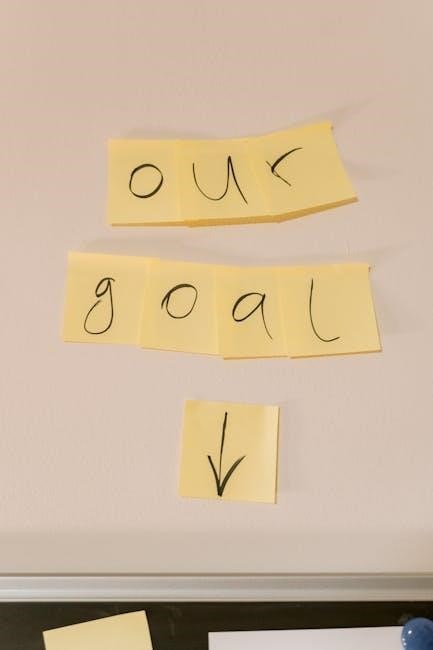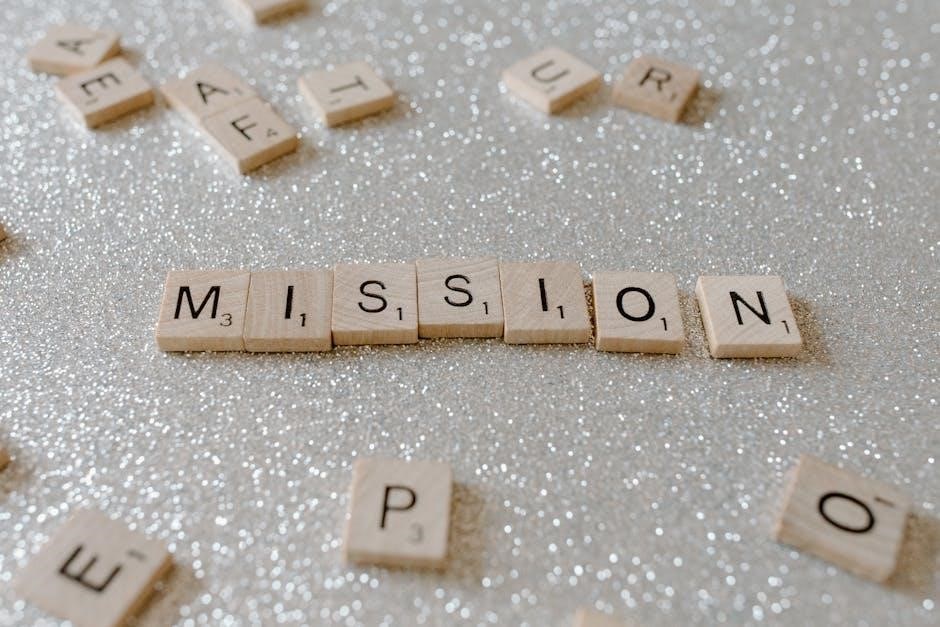Treatment Plan Goals and Objectives for ADHD
Treatment plans for ADHD aim to reduce the impact of symptoms on daily life․ They maximize the patient’s ability to cope with remaining difficulties․ This involves setting specific, realistic, and attainable goals․
Understanding the Core Goal of ADHD Treatment
The primary goal of ADHD treatment is to minimize the negative impact of ADHD symptoms on a patient’s overall functioning․ This encompasses various aspects of life, including academic performance, social interactions, and daily routines․ Simultaneously, treatment seeks to maximize the patient’s ability to compensate for or cope with any remaining challenges posed by ADHD․ It’s crucial to manage expectations, understanding that not all symptoms can be entirely eliminated through treatment interventions․ The focus is on improving daily functioning and restoring areas of impairment․
Minimizing Impact and Maximizing Coping Abilities
Effective ADHD treatment strives to lessen the disruptive effects of ADHD symptoms on an individual’s life․ This involves reducing academic impairment and improving school engagement for students․ It also focuses on improving interpersonal relationships by fostering better communication and understanding․ Simultaneously, treatment aims to enhance the individual’s ability to cope with ADHD-related challenges․ This may involve teaching strategies for self-control, impulse management, and organizational skills․ The goal is to empower individuals to navigate daily life more effectively, despite the presence of ADHD․
Key Components of Effective ADHD Treatment Plans
Successful ADHD treatment plans involve specific, realistic, and attainable goals․ These goals are broken down into smaller, achievable objectives․ Therapy skills are integrated into daily routines for better management of ADHD․
Specific, Realistic, and Attainable Goals
ADHD treatment goals should be specific, focusing on tangible outcomes․ They also need to be realistic, aligning with the individual’s capabilities and circumstances․ Attainable goals ensure progress and motivation․ Breaking down overarching goals into smaller, manageable objectives is crucial․ These objectives serve as stepping stones, making the larger goals less daunting; This approach supports sustained effort and a sense of accomplishment throughout the treatment process, fostering positive change․
Breaking Down Goals into Achievable Objectives
Transforming broad ADHD treatment goals into achievable objectives is essential for progress․ Objectives are smaller, measurable steps toward the larger goal․ This breakdown makes the overall treatment plan less overwhelming and more manageable․ Each objective should be clearly defined and have a specific timeline․ Regular monitoring of progress on each objective allows for adjustments to the treatment plan as needed․ This adaptive approach ensures the individual remains engaged and motivated throughout the process, enhancing the likelihood of success․

Areas Addressed in ADHD Treatment Goals
ADHD treatment goals address various areas, including interpersonal relationships․ These goals also focus on setting achievable SMART goals․ Ultimately, the goal is to improve daily functioning and reduce academic impairment․
Enhancing Interpersonal Relationships
A key area in ADHD treatment is enhancing interpersonal relationships․ This involves supporting better communication and understanding․ ADHD symptoms can sometimes be mistaken for disinterest or neglect․ Therefore, treatment focuses on improving social skills․ It also aims to foster empathy and effective communication․ Improving these skills helps patients maintain healthy relationships․ This includes family, friends, and romantic partners․ Enhanced relationships contribute to overall well-being and support networks․
Setting Achievable SMART Goals
Working with a therapist is crucial in setting achievable SMART goals․ SMART goals are Specific, Measurable, Achievable, Relevant, and Time-bound․ This framework ensures goals are well-defined and attainable․ It allows for progress tracking and celebrates successes․ Setting realistic goals is vital for motivation and self-esteem․ The therapist guides the patient in breaking down larger goals into smaller, manageable steps․ This approach increases the likelihood of success and promotes a sense of accomplishment; Ultimately, SMART goals empower individuals with ADHD․
Essential Objectives in ADHD Treatment Programs
ADHD treatment programs aim to describe comprehensive treatment plans․ They also identify psychosocial interventions for pre-adolescents․ These objectives ensure learners understand ADHD treatment components․ Programs should be detailed and educational for participants․
Describing Components of Comprehensive Treatment Plans
Comprehensive ADHD treatment plans encompass several components․ These include medication management, behavioral therapy, and educational support․ Psychosocial interventions and skills training are also crucial․ A well-rounded plan addresses various aspects of the individual’s life․ It focuses on academic, social, and emotional functioning․ Understanding these components is essential for effective ADHD management․ Individualized plans tailored to meet specific needs lead to better outcomes and improved quality of life․
Identifying Recommended Psychosocial Interventions
Psychosocial interventions play a vital role in ADHD treatment․ Cognitive behavioral therapy (CBT) helps manage symptoms and improve coping skills․ Parent training equips caregivers with effective strategies․ Social skills training enhances interpersonal relationships․ These interventions address emotional regulation and behavioral challenges․ They also foster self-esteem and resilience․ Identifying appropriate psychosocial interventions is essential for creating a comprehensive treatment plan․ Tailoring these approaches to individual needs maximizes their impact and promotes long-term well-being․
Practical Strategies and Techniques
Effective ADHD management involves practical strategies․ These include therapy skills integrated into daily routines․ Techniques such as meditation and self-control strategies can help delay gratification․ These promote long-term goal achievement․
Integrating Therapy Skills into Daily Routines
Incorporating learned therapy skills into everyday life is crucial for managing ADHD effectively․ This involves consistently applying techniques and strategies acquired during therapy sessions to real-world situations․ By integrating these skills, individuals can proactively address challenges and improve their daily functioning․ Regular practice reinforces these skills, making them more automatic and readily available․ This leads to sustained improvements in behavior, focus, and emotional regulation, ultimately enhancing overall quality of life․
Implementing Meditational and Self-Control Strategies
Meditation and self-control strategies are valuable tools for managing ADHD symptoms․ These techniques help individuals regulate impulses and delay gratification, fostering better decision-making․ Strategies like “stop, look, listen, and think” can interrupt impulsive reactions and promote thoughtful responses․ Regular meditation practice can enhance focus, reduce stress, and improve emotional regulation․ By consistently implementing these strategies, individuals can cultivate greater self-awareness and control over their behavior, leading to more meaningful and long-term goal achievement․
Academic Goals and Objectives for Students with ADHD
Academic goals for students with ADHD focus on reducing academic impairment․ They aim to improve school engagement and overall performance․ Specific objectives might include better attendance and focused studying habits․
Reducing Academic Impairment
One of the primary academic goals for students with ADHD is reducing academic impairment․ This involves addressing challenges that hinder their learning process․ These challenges could include difficulty focusing, staying organized, and completing assignments․ Effective strategies and interventions can help students manage these symptoms․ The goal is to enable them to achieve their full academic potential, promoting a more positive and successful educational experience․ This may require tailored educational approaches and support systems․
Improving School Engagement and Performance
Another key academic goal focuses on improving school engagement and overall performance․ Students with ADHD often struggle with staying motivated and participating actively in class․ Treatment plans aim to foster a more positive attitude towards learning․ Strategies may include making lessons more interactive, providing frequent positive reinforcement, and breaking down tasks into manageable steps․ By addressing these issues, students can experience increased academic success and a greater sense of accomplishment in their school environment․ The aim is to create a supportive and stimulating learning atmosphere․

Behavioral Therapy in ADHD Treatment
Behavioral therapy is crucial for children with ADHD․ It focuses on strengthening positive behaviors while reducing unwanted behaviors․ This approach helps manage symptoms and improve overall functioning in various settings․
Strengthening Positive Behaviors
One key aspect of behavioral therapy in ADHD treatment is actively strengthening positive behaviors․ This involves identifying desired actions and implementing strategies to encourage their repetition․ Reinforcement techniques, such as praise and rewards, play a vital role in motivating individuals to exhibit these positive behaviors consistently․ By focusing on what the individual does well, therapists can help build confidence and create a positive feedback loop that promotes continued success and reduces reliance on negative behavioral patterns․
Eliminating Unwanted Behaviors
A crucial component of behavioral therapy for ADHD involves addressing and eliminating unwanted behaviors․ This requires a careful analysis of the triggers and consequences associated with these behaviors․ Strategies such as redirection, planned ignoring, and time-outs can be employed to reduce the frequency and intensity of problem behaviors․ It’s essential to replace unwanted behaviors with positive alternatives, teaching individuals more appropriate coping mechanisms and social skills․ Consistency and clear expectations are paramount for successfully eliminating unwanted behaviors․

Improving Daily Functioning
The aim is to improve day-to-day functioning in areas of impairment, not just suppress symptoms․ This involves strategies to restore function, reduce symptoms, and enhance the ability to manage daily tasks effectively․
Focus on Areas of Impairment
ADHD treatment should prioritize improving specific areas where the individual experiences difficulties․ This targeted approach ensures that interventions directly address the most pressing challenges, such as academic performance, interpersonal relationships, or organizational skills․ Identifying and focusing on these areas of impairment allows for a more tailored and effective treatment plan, leading to improved daily functioning and overall well-being․ By addressing these specific challenges, the individual can experience tangible improvements in their quality of life․
Reducing or Eliminating Symptoms
A primary objective of ADHD treatment is to alleviate or eliminate core symptoms like inattention, hyperactivity, and impulsivity․ Achieving remission of these symptoms can significantly improve daily functioning and quality of life․ Treatment plans often incorporate medication, therapy, or a combination of both to target symptom reduction․ By effectively managing these symptoms, individuals with ADHD can experience greater success in academic, professional, and social settings, ultimately leading to a more fulfilling and productive life․

Free Resources and Tools
Utilize free resources like the Mentalycs worksheet for ADHD goal setting․ These tools improve communication and enhance treatment outcomes․ Such resources help to set clear, achievable objectives for patients․
Mentalycs Worksheet for Goal Setting
The Mentalycs worksheet is a free tool designed to aid in setting clear and measurable goals for ADHD treatment․ It helps improve communication between patients, therapists, and families; By using this worksheet, individuals can break down larger treatment goals into smaller, more manageable objectives․ This facilitates progress tracking and enhances overall treatment outcomes․ The worksheet assists in creating specific, realistic, and time-bound goals, which are crucial for effective ADHD management and improved daily functioning․ Download to improve treatment today!
The Importance of Individualized Treatment
Every child’s ADHD treatment must be tailored to meet unique needs․ This starts with target outcomes for behavior․ Individualized plans address specific areas of impairment․ They promote improved daily functioning and symptom management․
Tailoring Plans to Meet Individual Needs
Crafting ADHD treatment plans necessitates a personalized approach․ A cookie-cutter strategy will not suffice․ Each individual experiences ADHD differently, with varying symptom presentations and life circumstances․ Effective treatment addresses the unique challenges and strengths of the person․ It considers their specific impairments, be it academic struggles, interpersonal difficulties, or challenges in daily functioning; By tailoring interventions, we maximize the likelihood of positive outcomes and lasting improvements in quality of life․




